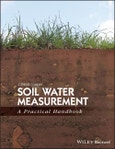The theory and practice of the workings of the main instruments and methods available is described, along with practical tips on surmounting some of the main difficulties and explanations of many commonly encountered jargon words.
Table of Contents
Preface vi
Part I: Introduction 1
1 Soil Water in Context 3
2 How Does Water in Soil Interact with the Soil Matrix, Air, Roots, Gravity and Other Substances Present? 6
3 What Do We Need to Measure? 14
4 Spatial Variability 16
Part II: Water Content 21
5 Definitions 23
6 Gravimetric Method 26
7 Neutron Scattering 43
8 Dielectric METHODS 101
9 Dual-Probe Heat-Pulse Sensors 150
10 Electrical Resistivity Imaging 152
Part III: Water Potential 159
11 Water Potential Measurement 161
12 Tensiometers 164
13 Indirect Methods of Water Potential Measurement 203
14 Beyond −10 Metres Water Head 214
Part IV: Water Content – Potential Relations 223
15 Soil Water Characteristic Measurement 225
Part V: Hydraulic Conductivity 237
16 Hydraulic Conductivity Measurement and Prediction 239
17 Hydraulic Conductivity Measurement of Confined Soil Samples 241
18 Unconfined Measurements in the Field 257
Part VI: Solute Measurement 277
19 Principles and Pitfalls 279
20 Solution Sampling 283
21 Solute Concentra tion Estimation by Electrical Conductivity 292
Part VII: Water and Solute Movement 301
22 Water and Solute Transport Applications 303
23 Water and Solute Flux Measurement 306
24 Soil Water and Solute Balance Measurement and Estimation 312
Part VIII: Conclusion 333
25 Concluding Remarks 335
References 336
Index 353








